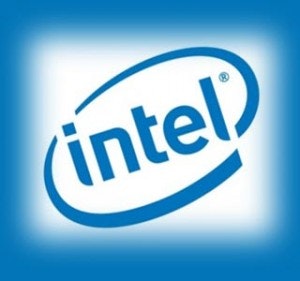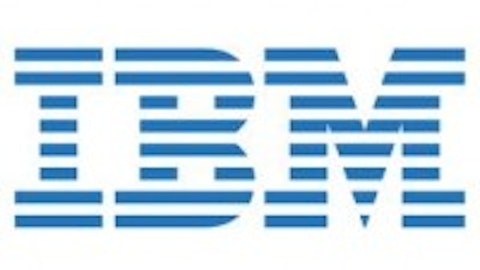
Intel Corporation (NASDAQ:INTC), the company that at one time held a 95% market share in global PC-based processors, has endured a proverbial fall from grace of late. In fact, the firm’s current earnings report clearly shows that the once-unbeatable giant has posted a fall in profit in the neighborhood of 25% — giving this firm a very unprofitable outlook going forward.
Taking one step forward and two steps back
Back in the roaring 1990s, Intel Corporation (NASDAQ:INTC) pulled in profits from its design, manufacture, and sales of integrated digital technology platforms throughout the world. The company currently holds a market cap that is nearly $120 billion — although that is likely to continue to shrink over time unless the company makes some drastic changes.
One key issue that Intel is grappling with today is the movement of consumers who are shying away from more “bulky” personal computers. Given this, Intel has struggled, and is currently being surpassed by a number of its competitors in key areas.
One way that Intel Corporation (NASDAQ:INTC) has opted to deal with its present scenario is by cutting its plans for capital spending for this year by $1 billion overall. Yet, when comparing this to the potential $12 billion in spending that Intel is planning, its spending cuts look more like just a drop in the bucket.
In addition, any positive profit-related outlook for the near-term is essentially being based on a mixed bag of mere probabilities — the launch of new kinds of processors and an increase in sales of touchscreen laptop computers. In any case, such future projections appear to be weak at best — along with being a real gamble:
1- Leaked Intel Haswell APU Results show Disappointing Performance
2- Haswell Could Have Compatibility Problems With Older PSUs
Haswell is another Intel (product). They always promise, and never deliver. It is not about performance in a synthetic (benchmark) it is about (that) they don’t support essential features we need and don’t need to worry about compatibility on (our) code. Fusion, Radeon and GeForce have it all covered and if we have issues they resolve them or work (with us). Forget it they live in a mobile world right now.
The Intel effort to integrate a voltage regulation (VR) stage into the Haswell architecture appears to have fallen short of desired results.
the industry sources we spoke with indicated Haswell is working, but that “the new power approach did not live up to expectations.
Living in a disposable world
While Intel is still considered a leader when it comes to chips used for powering PCs, the company is running into revenue issues here as well — due in large part to the fact that most people are moving away from being tied to a personal computer in lieu of relying more and more on their mobile devices such as tablets and smartphones.
Unfortunately, Intel Corporation (NASDAQ:INTC) is not considered an early adopter in this particular arena. In fact, as global shipments of personal computers continue their downward slide, Intel’s revenue is likely to continue its downward spiral too, especially given that the company obtains most of its earnings from the sales of PCs and related items.
Investors should start believing that 65% gross margin seen over the last couple of years is a thing of the past. A potentially low 50% gross margin is an increasing reality, and investors should embrace the lower estimates. Adding even more fuel to the fire is the fact that some of Intel’s largest purchasers — Dell Inc. (NASDAQ:DELL) and Hewlett-Packard Company (NYSE:HPQ) for instance — are also facing decreasing sales, which are leading to lower revenues.
Competition could be to blame — or is it?
Although slumping revenue is typically easier to swallow if a company can point their finger at its competitors, this is not necessarily the case here. Considering that Intel has held less than a 2% market of the mobile-based processor market since last year, the finger pointing may need to reverse itself right back to Intel itself.
With this in mind, Intel’s competitors are also surging forward in the mobile device arena. Take, for example, QUALCOMM, Inc. (NASDAQ:QCOM). This company has its processors in the handsets of products that are produced by smartphones leaders such as Samsung, Apple Inc. (NASDAQ:AAPL), and HTC. Adding to this is the substantial amount of money being saved — and risk being avoided — by QUALCOMM, Inc. (NASDAQ:QCOM) in that it doesn’t own any chip-producing factories, but rather contracts with its suppliers.
Taking heed from a leader
Intel is not alone in its proverbial fall from grace in the processor market. The declining personal computer market has also had a grave effect on the likes of Microsoft Corporation (NASDAQ:MSFT). Due in part to the so-so demand for Microsoft’s new Windows 8 operating system, the company that once had a highly profitable partnership with Intel is also starting to feel the heat.
The big difference, though, between how Intel Corporation (NASDAQ:INTC) and Microsoft Corporation (NASDAQ:MSFT) have dealt with the PC market decline is that Microsoft has opted to form a partnership with Nokia Corporation (ADR) (NYSE:NOK), a giant in the smartphone sector — to feature the Windows OS on certain Nokia Corporation (ADR) (NYSE:NOK) devices.
Making matters worse for Intel is the fact that a majority of the smartphones that use this operating system are working on chips that are manufactured by QUALCOMM, Inc. (NASDAQ:QCOM). When it comes to non-PC related collaboration with Microsoft i.e. mobile and console, the last nail in Intel’s coffin could be the upcoming partnership between Microsoft Corporation (NASDAQ:MSFT) and Advanced Micro Devices, Inc. (NYSE:AMD) to use AMD’s chips in the new Xbox game consoles.
Investors are keeping their heads in the clouds
Given that fewer consumers are relying on PCs anymore, and coupled with Intel’s lackluster forward movement into the mobile device arena, and the high risks attached in doing so, investors who are considering the purchase of shares — or more shares — may first need to come down from the clouds.
With the massive head start that companies such as Qualcomm have with mobile technology, along with some of the strategic partnerships that have been forged with Intel’s competitors, the outlook for any profit growth at all — other than a $0.90 per share dividend — from shares of this fallen chip maker is bleak.
A realistic bottom line
Although the shares of Intel Corporation (NASDAQ:INTC) are now trading significantly above the company’s 52-week low, the unfortunate truth is that Intel is not likely to turn itself around before long. With such a large share of Intel’s revenue coming from the dying PC market, sales from its server segment might not be enough to offset this rapid decline. And, as far as mobile-world penetration goes, Only time will tell if Haswell will be worth the investment.
The article Overconfidence Continues to Chip Away at Earnings originally appeared on Fool.com and is written by Nauman Aly.
Nauman Aly has no position in any stocks mentioned. The Motley Fool recommends Intel. The Motley Fool owns shares of Intel, Microsoft, and Qualcomm. Nauman is a member of The Motley Fool Blog Network — entries represent the personal opinion of the blogger and are not formally edited.
Copyright © 1995 – 2013 The Motley Fool, LLC. All rights reserved. The Motley Fool has a disclosure policy.


